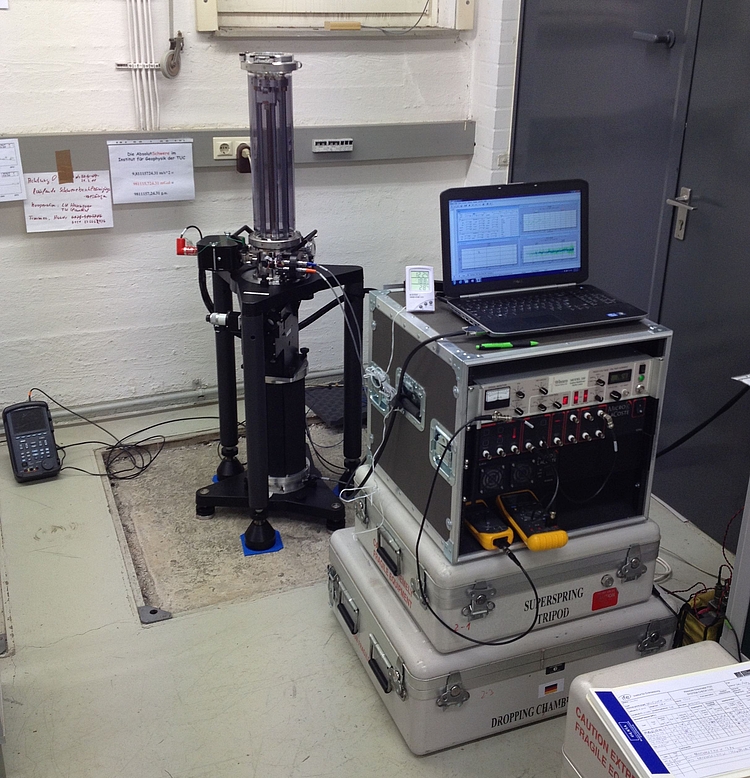Current Research Projects
Traceability of the FG5X-220 to the SI units
 © IfE / M. Schilling
© IfE / M. Schilling
| Led by: | Dr.-Ing. Ludger Timmen |
| E-Mail: | timmen@ife.uni-hannover.de |
| Team: | Dr.-Ing. Ludger Timmen, M. Sc. Manuel Schilling |
| Year: | 2012 |
| Is Finished: | yes |
Overview
Absolute gravimetry allows monitoring of secular gravity variations over time spans of several years to decades. In the center of the Fennoscandian land uplift area gravity decreases with approximately 2µGal/year. The determination of this rate and even smaller ones further away from the central area, requires annual measurements for at least 5–10 years. The recent FG5 and FG5X type absolute gravimeters also reach a repeatability of about 2µGal. For most applications in geodynamics the observation of temporal gravity variations are important and a constant measuring offset to the true value of g can be accepted. For the reproducibility of the instruments measurement a stable offset to the true value of g over several years is a necessity. Otherwise, an unknown change of the offset might be interpreted as a geophysical signal.
Additionally the FG5-220, which is operated bei IfE since 2002, was upgraded to the latest Version, the FG5X-220. Several major components were change in the upgrade. In addition to a new dropping chamber with longer free fall distance, which changes the instruments reference height, the complete electronics were replaced. In order to continue timeseries which were started in the mid 1980s with the JILAg-3 at some stations, a thorough investigation of this instruments offset is required.
Methodology
The real g-value with a superior accuracy is not known, and a standard absolute gravimeter which is superior to the state-of-the-art FG5 meters does not exist. The long term stability is monitored and the traceability to the SI unit is established by the combination of two approaches:
- the independent calibration of integrated working standards, and
- the comparison with a reference.
Calibration of internal standards
The interferometer signal is timed with an internal 10MHz rubidium oscillator. This frequency of this oscillator changes with time, e.g., due to aging, which manifests itself in a small drift effect. This effect is determined by regular comparisons with a frequency standard of higher accuracy. This is either a GPS stabilized rubidium oscillator or at a national metrology institute.
The length unit itself is established by the interferometric measurement. The wavelengths of the Helium-Neon laser light are currently not directly compared to a reference. A significant change would be detected by direct comparisons with other gravimeters.
Results
Numerous frequency comparisons of the FG5X rubidium were done since the upgrade of the FG5X. These are usually made prior and after measuring campaigns. The results are presented in figure 1. The FG5X was exposed to higher levels of atmospheric helium in July of 2014 which caused an increase of the frequency of 0.01Hz. Undetected, this increase would result in an error of 2µGal in a measurement of g. The frequency decreases since this helium event even below the frequency otherwise reached by normal aging.
Figure 1: Difference of frequencies between FG5X-220 rubidium oscillator and a reference.
Comparison with a reference
The FG5X-220 is participating in international comparisons of absolute gravimeters on a regular basis and is compared to the reference value determined by the participants of national metrology institutes. The degree of equivalence, determined from several measurements, is the indicator of the instruments long-term stability.
Results
The results of all international comparisons in which the FG5-220 and the upgraded FG5X-220 participated are shown in figure 2. The depicted Degree of Equivalence is the instruments deviation from the official reference value with its uncertainty according to the technical protocol of the respective comparison. Since 2009 these comparisons are recognized as key comparisons in the scope of the CIPM-MRA.
RICAG are regional comparisons hosted at the geodetic observatory in Wettzell and organized by the German Federal Agency for Cartography and Geodesy with 6 participants. The presented value is the deviation from the mean of all participants.
Figure 2: Results of the FG5-220 and FG5X-220 in international comparisons of absolut gravimeters.
The FG5X-220 also participated in the EURAMET.M.G-K2 key comparison in 2015 in Luxembourg. This result has not been published yet.
The results of the key comparisons are published in the BIPM key comparison database.




